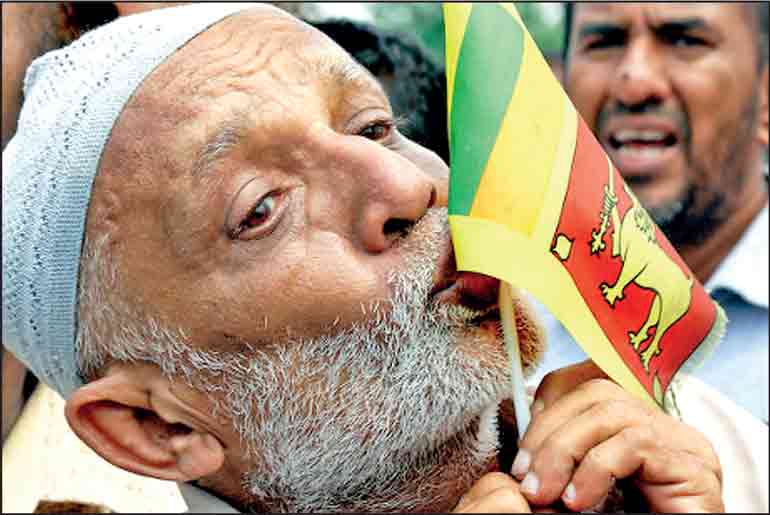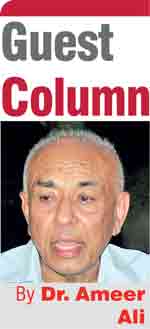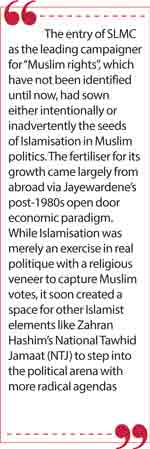Monday Oct 13, 2025
Monday Oct 13, 2025
Monday, 13 October 2025 00:20 - - {{hitsCtrl.values.hits}}

Islam in Sri Lanka has a proud history as an integrated element of the nation’s cultural mosaic. Post-SLMC identity politics appears to be threatening this integrated edifice
 Since 1980s when Sri Lanka Muslim Congress (SLMC) entered the country’s political arena Muslim politics and Muslim culture began to develop a symbiotic relationship to strengthen the community’s identity politics. The fact that identity politics was the norm and not the exception at that time may be the justification for such an amalgam. Yet, even at that time the pre-SLMC Muslim leaders had the wisdom and foresight to avoid falling into that identity trap and were able to utilise their commercial tool of bargaining between the existing parties to get the best deal for their community. It was politics of pragmatism as came to be known later.
Since 1980s when Sri Lanka Muslim Congress (SLMC) entered the country’s political arena Muslim politics and Muslim culture began to develop a symbiotic relationship to strengthen the community’s identity politics. The fact that identity politics was the norm and not the exception at that time may be the justification for such an amalgam. Yet, even at that time the pre-SLMC Muslim leaders had the wisdom and foresight to avoid falling into that identity trap and were able to utilise their commercial tool of bargaining between the existing parties to get the best deal for their community. It was politics of pragmatism as came to be known later.
What made this bargaining possible was the ubiquitous presence of Muslim voters in several parliamentary constituencies across the country. Also, the growing discontent between the Sinhalese and Tamil politicians from 1950s further strengthened the hands of Muslim leaders. As a result, special privileges were granted to the Muslim community as part of affirmative action. For example, the origins and growth of Muslim primary schools, Muslim Maha Vidyalayas, and Muslim training colleges is an outstanding testimony for the success of pragmatic politics.
What is even more significant and not well researched by scholars is the fact that Muslim politics did not disturb the millennium old historic and peaceful integration of this community into Sri Lanka’s multi-ethnic polity. Muslims in every aspect had become a community OF and not IN Sri Lanka. After the 1980s and with the growth of SLMC identity politics however, this healthy integration seems to have received a setback with the intrusion of cultural elements into Muslim politics.
Without going into the origins and ideological foundation of SLMC which had been dealt with in author’s earlier columns in this journal let the readers pose the question to SLMC leaders as to what their specific achievements were since that party came into existence. On the other hand, the Muslim cemetery at Majma Nagar in Oddamavadi bears witness to the monumental failure of SLMC leaders to prevent the cremation of corona-dead Muslims during Gotabaya’s presidency. Recently, someone had highlighted that the South-Eastern University in Oluvil is the achievement of SLMC during the time of its founder president Ashraf. True, but the groundwork for a university in that region began during the time of former Minister of Education Badiuddin Mahmud, and had his government been returned at the 1978 General Election today’s Eastern University would have been built somewhere in the Southeast.
Sowing the seeds of Islamisation in Muslim politics
 Be that as it may, the entry of SLMC as the leading campaigner for “Muslim rights”, which have not been identified until now, had sown either intentionally or inadvertently the seeds of Islamisation in Muslim politics. The fertiliser for its growth came largely from abroad via Jayewardene’s post-1980s open door economic paradigm. While Islamisation was merely an exercise in real politique with a religious veneer to capture Muslim votes, it soon created a space for other Islamist elements like Zahran Hashim’s National Tawhid Jamaat (NTJ) to step into the political arena with more radical agendas.
Be that as it may, the entry of SLMC as the leading campaigner for “Muslim rights”, which have not been identified until now, had sown either intentionally or inadvertently the seeds of Islamisation in Muslim politics. The fertiliser for its growth came largely from abroad via Jayewardene’s post-1980s open door economic paradigm. While Islamisation was merely an exercise in real politique with a religious veneer to capture Muslim votes, it soon created a space for other Islamist elements like Zahran Hashim’s National Tawhid Jamaat (NTJ) to step into the political arena with more radical agendas.
While SLMC campaign platforms created a religious flavour with party stalwarts appearing with beards and white caps, and while their mullahs addressing the crowd with quotes from the Holy Quran and Prophet’s sayings amidst shouts of Allahu Akbar, NTJ went a step further and advanced radical measures not simply to enter the Parliament but to change Sri Lanka itself from ‘Dharul Qufr’ (Abode of Non-believers) to ‘Dharul Islam’ (Abode of Islam). The whole truth behind how this group eventually became a bunch of mercenaries at the hands of more sinister elements from outside the Muslim community and eventually perished in blood is yet to be revealed in full. But the point to note here is the danger of promoting identity politics with religious and cultural ingredients.
There is another disturbing development which is also an indirect consequence of SLMC’s identity politics. This is the growing trend towards Arabisation of Muslim towns like Kattankudy. This enclave, which was described earlier by this columnist as a “Mullah Merchant Urban Settlement”, is now transforming into a Mullah Merchant Arab Complex. In fact, a recent Muslim tourist from Azerbaijan who visited Kattankudy did describe it as an Arab town in Sri Lanka. With around 50,000 population of whom nearly 90% are Muslims living cramped inside a land area of only 2.56 km2, with nearly 70 mosques crowned by a replica of the historic Al-Aqsa in Palestine and with street junctions and arches decorated with Arabic calligraphy, and on top of all these with a row of date palms in the middle of Kattankudy main street give this enclave a Middle Eastern flavour which is alien to Sri Lanka. Added to these elements is the “confronting” attire (as one foreign prime minister described to this columnist) worn by Muslim men and women in the name of a so-called cultural dress. A brief note on this attire is relevant in this context.
Muslim attire is adding to self-alienation
None can deny one’s right to wear whatever dress one likes. It was on that argument few years ago a couple of Muslim lady teachers in Trincomalee won their case in the court for contravening the school’s tradition of lady teachers coming in sarees. But how that victory added to the deteriorating social cohesion between Tamils and Muslims in that district escaped the notice of everyone. The same is true at the national level. Muslim attire is adding to self-alienation of Muslims in multi-cultural societies.
Recently, Prime Minister Harini Amarasuriya announced that Muslim girls could attend any school wearing their cultural dress and pursue their education. While welcoming this announcement it is left to the Muslim community to decide which is the most appropriate dress for their school children which, while conforming to the cultural norms of the society should not be an impediment to those children to participate fully in all school activities including co-curricular and extra-curricular ones. Excellence in academic performance should not be the sole objective of education for a Muslim child attending school.
Islam in Sri Lanka as noted previously has a proud history as an integrated element of the nation’s cultural mosaic. Post-SLMC identity politics appears to be threatening this integrated edifice as evinced by the title of a book authored by a local academic and published in 2025 with the title “Muslims in Sri Lanka” instead Muslims of Sri Lanka. That title seems to add substance to Dr. Colvin R. de Silva’s comparison of Muslim attachment to the country as that between a cow and the grass.
A post-Aragalaya irrelevance
The 2022 Aragalaya and its impact on the country’s political landscape marks a watershed in Sri Lanka’s post-independence history. The success of AKD at the Presidential Election and NPP at the General Election were, if anything, lasting testimonies for voters’ rejection of identity politics. And no critic with a catalogue of pre-election promises, and post-election failures of the new president and Government could accuse them of communal or religious bias. In short, identity politics is a post-Aragalaya irrelevance. Yet, reactionary elements are regrouping to reinstate the ancient regime as soon as possible, because there are too many skeletons in the cupboard that are threatening to reopen hidden secrets about the felonious past of some previous leaders. Imtiaz Bakir Makar’s VAT ghost is the latest revelation demanding investigation. No wonder SLMC and its breakaway ACMC are back in the field to bargain with other reactionaries more for personal than community benefits. Will the community wake up?
(The writer is a retired economist, W. Australia.)